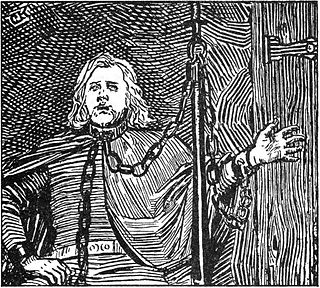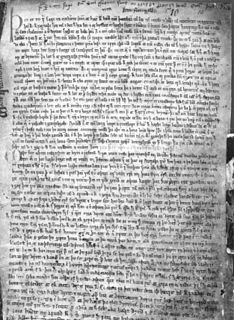Einarr Gilsson was an Icelandic poet and official. He was the lögmaður of northern and western Iceland from 1367 to 1369. He is mentioned already in letters dating from 1339 and 1340 but his years of birth and death are unknown. He appears to have lived in Skagafjörður. [1]

Iceland is a Nordic island country in the North Atlantic, with a population of 348,580 and an area of 103,000 km2 (40,000 sq mi), making it the most sparsely populated country in Europe. The capital and largest city is Reykjavík, with Reykjavík and the surrounding areas in the southwest of the country being home to over two-thirds of the population. Iceland is volcanically and geologically active. The interior consists of a plateau characterised by sand and lava fields, mountains, and glaciers, and many glacial rivers flow to the sea through the lowlands. Iceland is warmed by the Gulf Stream and has a temperate climate, despite a high latitude just outside the Arctic Circle. Its high latitude and marine influence keep summers chilly, with most of the archipelago having a tundra climate.

A lawspeaker or lawman is a unique Scandinavian legal office. It has its basis in a common Germanic oral tradition, where wise people were asked to recite the law, but it was only in Scandinavia that the function evolved into an office. Two of the most famous lawspeakers are Snorri Sturluson and Torgny the Lawspeaker.

Skagafjörður is a deep bay in northern Iceland.
Contents
Einarr was the author of Ólafs ríma Haraldssonar, a ríma on Saint Óláfr Haraldsson consisting of 65 ferskeytt verses. Preserved in Flateyjarbók, it is sometimes considered the earliest known ríma. [2] Einarr's other preserved works are poems on Bishop Guðmundr Arason which have come down to us in Guðmundar saga biskups by Arngrímr Brandsson. These consist of a biographical dróttkvætt poem on the bishop focusing on his wonder-working, a shorter hrynhent poem on Guðmundr's conversations with archbishop Þórir of Niðarós and a flokkr on Guðmundr's struggle with the supernatural being Selkolla. [3]
Ólafs ríma Haraldssonar is a 14th-century ríma by the Icelandic poet and official Einarr Gilsson on the career of Saint Óláfr Haraldsson of Norway.

Olaf II Haraldsson, later known as St. Olaf, was King of Norway from 1015 to 1028. He was posthumously given the title Rex Perpetuus Norvegiae and canonised at Nidaros (Trondheim) by Bishop Grimkell, one year after his death in the Battle of Stiklestad on 29 July 1030. His remains were enshrined in Nidaros Cathedral, built over his burial site. His sainthood encouraged the widespread adoption of the Christian religion among the Vikings / Norsemen in Scandinavia.
Ferskeytt is an Icelandic stanzaic poetic form. It is a kind of quatrain, and probably first attested in fourteenth-century rímur such as Ólafs ríma Haraldssonar. It remains one of the dominant metrical forms in Icelandic versifying to this day.
Finnur Jónsson characterized Einarr's poetry as "dry narratives without any poetic flight" [4] and that as a poet Einarr is to be rated "on the whole, not highly". [5]



